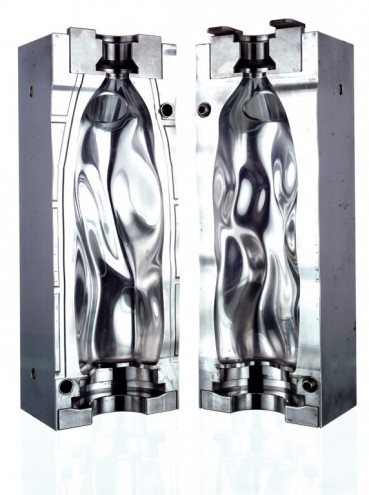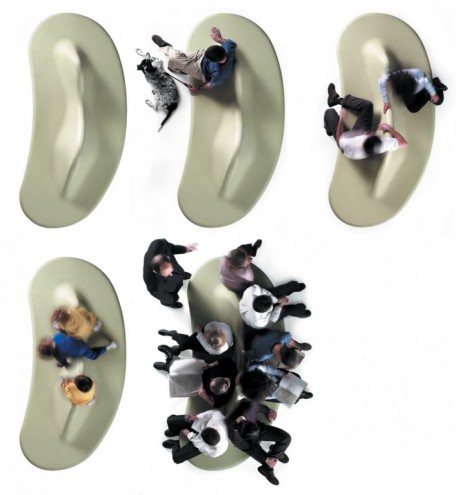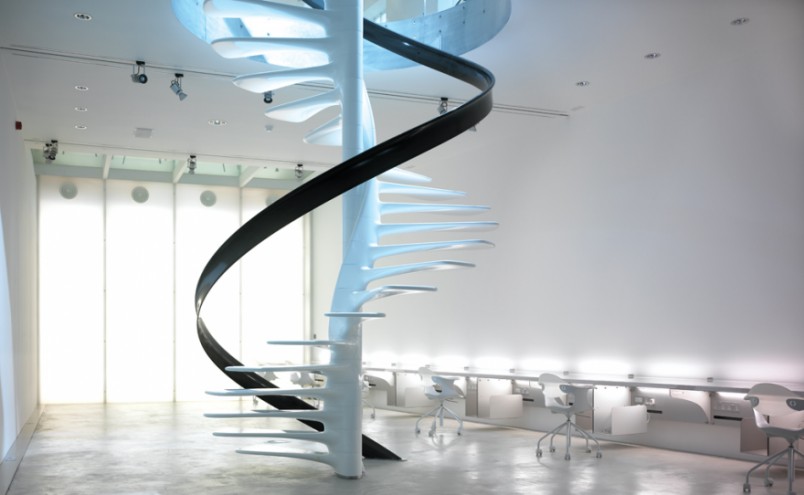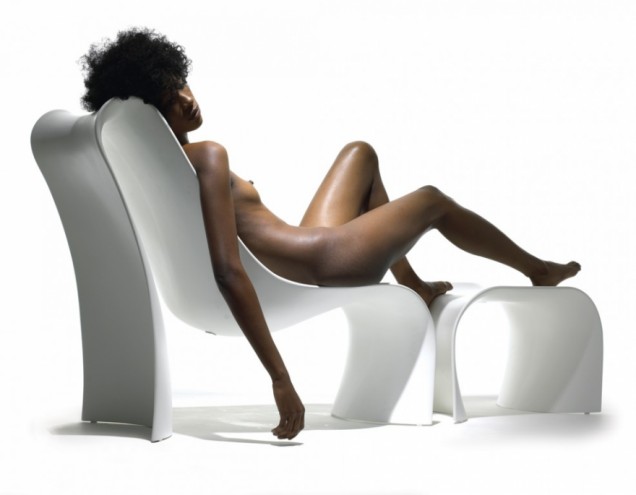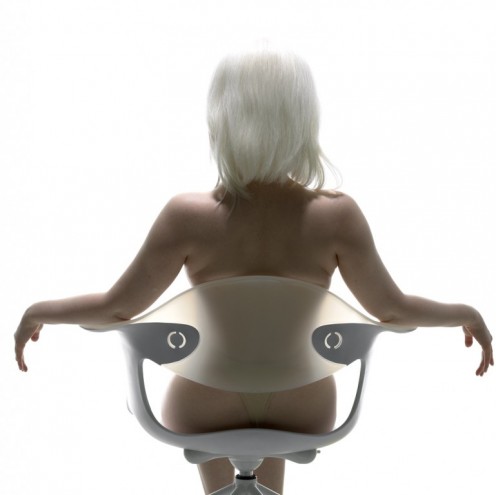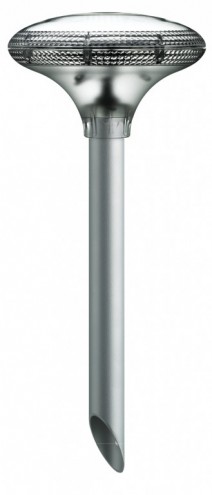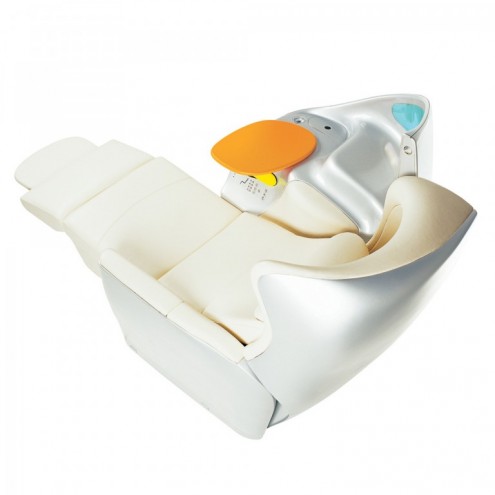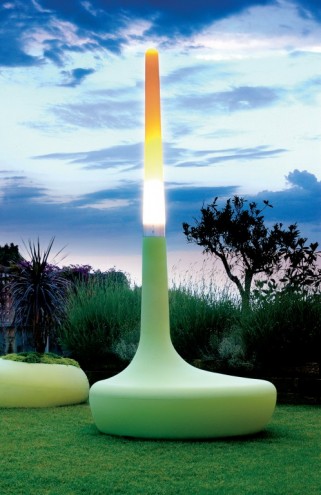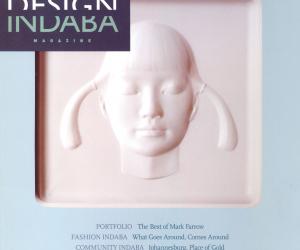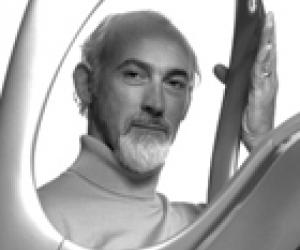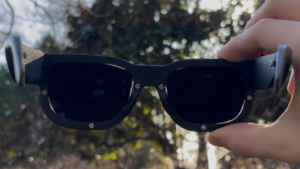First Published in
Ross Lovegrove is sculptor of ordinary things. He is an artisan with a knack for infusing everyday objects with an alluring poetry. Ross Lovegrove is also simply an industrial designer. While the cynic's view is unfailingly factual, it is somewhat bereft. Yes, Ross Lovegrove is an influential designer of functional everyday objects, but he is also a forward-thinking creator of objects possessed with an utterly unexpected beauty.
Take, for example, his recent furniture project for the Spanish company B.d Ediciones. Lovegrove's rotation moulded polyethylene Transit Furniture Concept is distinctively sculptural, and noteworthy for its strikingly organic sensibility. Somewhat paradoxically - they are just chairs after all - his creations don't really make one want to sit down. Rather, one is tempted to just stand, to observe, to simply partake in the delirious charm of his furniture's cohesive form.
The fact that Lovegrove is a great admirer of post-War British sculpture probably accounts for something here. Quizzed about his interest in sculpture, the Wales-born graduate of Manchester Polytechnic and London's Royal College of Art expresses deep fondness for two immense, if rather diverse, sculptural talents: Henry Moore and Anish Kapoor.
Knowing this, it is somewhat less difficult to trace some (certainly not all) the influences that feed into his product designs. Still with his Transit furniture range, the fluid progression of Lovegrove's design here shares something of Kapoor's fascination for monolithic, mono-coloured organic forms. Working with fluid shapes and rich colours, and informed by persuasive new technologies, Lovegrove's work is emerging as a benchmark designer for the twenty-first century.
Lovegrove is, however, neither pious, nor self-righteous about his ethical stance, as his interview reveals.
He was once young too. Singled out as a star performer at college, Lovegrove began his career with the industrial design consultancy Frog Design, in Germany in the 1980s.
His project designs included Walkmans for Sony and computers for Apple. Later, in France, he was part of the Atelier de Nimes, and alongside Philippe Starck and Jean Nouvel worked as a consultant for companies like Cacharel, Louis Vuitton and Hermès.
In 1990 Lovegrove inaugurated Studio X, his own personal studio in London's Notting Hill. The studio has released such groundbreaking designs as the digital camera Eye (1996) for Olympus, the Coachline (1992) luggage for Connolly and prototype Ammonite (1996) for Apple. Amongst his more recent achievements, Lovegrove has been involved with interior studies for the new Airbus A380. Due to be launched in 2005, this 680-seater plane will be the largest commercial aircraft ever to be developed.
Lovegrove's assiduous commitment to his profession has seen him earn accolades and awards aplenty. His products now enjoy something of a cult status. Indeed, some of his better-known creations have even been exhibited in the Museum of Modern Art and Guggenheim Museum, both in New York. His involvement with London's Design Museum is longstanding; Lovegrove curated the first Permanent Collection Exhibition in 1993.
Accounting for his success, Lovegrove told me: "It is more important for me to come across as an individual; a sculptor with a philosophy rather than somebody who can claim to have made a million selling some waste bin. I can do that, but that isn't what drives me. I come from a very primitive, primordial way of thinking, very rooted and intuitive".
If you had to go back a bit and look at yourself, was product design something you started tinkering with at an early age?
No. When I was younger, not that I am that old, product design wasn't a very known thing, even though it existed as profession. When I went to study on my foundation course, I did everything from fashion to graphics. The industrial design part of it was regarded as really un-trendy and nerdy, really not the thing to do. The irony there is that at the age of 17, when you look around and see a light switch in a car, a pair of shoes, a watch, people like me design all those things.
I see the word organic appear often when you speak of your work in interviews. I also read that you admire the work of the sculptor Anish Kapoor. How influential is the artworld on your product?
Oh completely. I don't care for the word product design; it seems extremely commercial and popular to me. I avoid that. In fact, when people ask me about product design I don't even know what to say because I am creative. I work in every field. I try and imbue everything I do with a value system, a certain trinity of everything that is required. When you design consumer products, one has a moral and ethical responsibility to society, and the ecology as a whole, to make sure what you do is succinct on all levels. That succinctness will lead you to success because in that case, less is more.
Back at college, everyone wanted to become groovy fine artists. The thing is that I bring art into what I do. I see [my creations] as an art form. I am very cautious that my work is perceived the right way. I've worked long and hard to mould it into something that I feel has value. I don't treat design remotely flippantly, I am very prolific in my thinking and I am extremely considered in what I produce.
How does one apply this type of philosophy to the type of world we inhabit today, one that eulogises the potential of the Made-in-China-tag. How do you apply a sense of morality and ethics to industrial design?
It is very difficult because you are talking to somebody who is going through a whole new phase of who I am and what I do. I have a certain sense of destiny. I have a feeling that I have a role to play in this whole creative world I am in; I am just trying to understand where all the focus is. The problem I have at the moment is that I am working in a field where I don't agree with a lot of what goes on. I am not particularly consumerist; I don't like artificially induced consumerism, which is one of the biggest disservices to humanity. I don't like profiteering; I like the idea of actual reality, of handing over money for things that have fair value. I don't treat the resources we have in this world lightly, I really don't. I can find more reasons not to do things than I can to do them, which is extremely dangerous.
For example, when I did my water bottle for Ty Nant, a very organic piece that has been incredibly successful (it sold 20 million bottles in one year - I wish I had a royalty on that one). I spent three months looking at crushable bottles, collapsible bottles, materials, all that sort of stuff. I looked at the ecological and the engineering aspects and couldn't solve the problem, because all the results I came up with felt like pieces of engineering. They didn't feel like they celebrated the beauty of water. My conclusion, at that time, after the three months, was to give the money back to the client. I told him that I realised clouds transport water better than bottles ever could or should. I outdid myself on my intellectual position. The client, however, talked me through things and gave me more time. After a time I came up with what you see, and I am very proud of it.
The fact of the matter is that being involved in the manufacture of things, when you travel and go to places like China, there is such an overwhelming sense of making, of using resources - for what end I don't know. I know that China is becoming the manufacturer of the world but there is a price to pay for that. Things then have to be shipped and there is a cost to that. I am not one of those persons who rub their hands together and say, 'Wow, I'm heading over to China to make a fortune'. I have couple of things being made out there, but it is because it's the way the projects are structured. The clients don't even pay for a ticket for me to go out. Basically you're pressing a button here for it to be made somewhere else, and I don't generally feel too good about that.
Students and young designers often say that it is easy for older designers to take such lofty positions. Looking back on your own career, were there ever occasions you felt you compromised your own value systems?
I was brought up to be very resourceful and frugal, and thus I have a natural interest in things like windmills and solar energy. I see them as very beautiful, natural too - considering my upbringing. When people learn about this interest, they often think it's just a fashionable thing, but I have been like that since I was a little boy I have always had this respect for things.
To answer your question though, for young people starting out, to say that at age 22 you have this amazing philosophy that is going to change the world is fundamentally wrong. You don't know anything at 22. You can design for people but you have to experience people too, you have to live. And hence the great potency of Italian design, the great masters, these people who first and foremost lived, and whose work was essentially a by-product of that social understanding.
When you're young, because you're young, you don't have the influence or power. You might be seen as a hotshot, but that's often really in the context of a college or group of friends, as it was with me. It takes years to prove yourself. I designed my first thing when I was 16, and I'm 45 now, and I can't say that I have had a day off from thinking about creativity.
I am interested to learn a bit more about the design consultancy aspect of your work. When companies such as Olympus or Apple approach you, how much autonomy are you given? Otherwise phrased, how much push and pull is their involved in the final design? Is the final product a happy compromise, or are they something that you feel bears your distinctive signature?
I got taken out of a college a year before the Royal to work for Frog Design, who - at that time - were the very best. They were number one in the world and I was number seven in the company. It was a hell of an honour. I went from being a leading student to someone in a design consultancy in the middle of the Black Forest. I was working for Sony and Apple and all these companies; it was frightening, I didn't know anything. I had my own personal style, but I joined an organisation that had an organisational style.
I don't want to be negative about that because I learnt an awful lot, but I am not the kind of guy who says. 'Ooh, if I put that radius on there it will sell'. I can't tolerate that approach to design. So, basically my daily existence, and that of my staff, is hard because I have an intensely inventive spirit, which is not conducive to consultancy work. You can't earn a living like that, you can't be experimental with consultancy because you are too busy processing. I have spent the last 20 odd years avoiding and trying to escape anything remotely associated with consultancy.
Your comment reiterates something you said in an interview once, that you like to debate ideas in your studio, but it is by no means a democratic workplace.
At the end of the day I can't afford to have 16 styles, otherwise I don't exist. I work for myself; they work for me, not the other way round. So, in a sense, they come to me because I display a philosophy, and I have an approach to design that they want to share and be a part of. If they are not prepared to accept that, they must go work for someone else. What I see coming out of consultancies is a shower system that looks one way, a piece of luggage or coffee machine that looks another. They look like that because individuals design them and there is no common identity. The reason I get interesting projects is because the companies that come to me like my philosophy and spirit of invention.
I did a project for Issey Miyake, which involved me going to Kyoto and Takashimaya, to do research. While staying there, I made some preliminary sketches. I then returned to the office and worked on the project for six weeks, making models, listening to ideas. When Miyake eventually came to the studio I lined up all the various studio proposals. Miyake immediately walked straight to the one I did in Japan. Now that happens all the time. Very often it is the first, preliminary design. I am extremely instinctive, the more I fiddle with things the more I go wrong.
I want to pick up on something you spoke about earlier, the old masters. I know it's going back some, but what was it like to curate the first Permanent Collection at the Design Museum, in 1993? It must have been quite a sizeable task, I mean in terms of putting forward the best of what has preceded you.
Yes and no. You have to understand that there was no precedent and the museum didn't really know how this thing would run. If the truth be known, Sir Terence Conran in all his generosity only put up £25,000, which isn't a great deal of money to buy unique things. It was quite funny process too. [Laughs] I am quite abstract in the way I look at things. I found myself wondering that if you are going to buy things for a museum that the visiting public would be interested in, there ought to be other aspects of life that you can collect from. For example, I tried to buy a silicone breast implant. Have you ever tried to buy one? It's hilarious. [Laughs] You can't buy one…
…to put on your table.
Not unless you're an artist. I had to get someone to buy one for me. In the end I had to pretend to be an artist and say that I was going to use it in a certain way.
So being a designer didn't suffice?
[Laughs] No, a designer is the worst thing in this scenario. I also thought about buying a decoy tank, because what is always very interesting about the history of British warfare is that the English were always very tricky. The inflatable decoy tank is a great design in terms of deception. When I however, told Sir Terence over lunch what I had bought, he nearly spat out his wine. He wouldn't let me do it; the show was edited somewhat. There were a couple of good things on the show, though, like those really crappy, plastic garden chairs that we see everywhere. I am the only designer in the world who loves those. I keep telling people that. I can't stand the snobbery that exists in design. Those plastic garden chairs that you see on balconies in Cairo…
… and Cape Town.
Fantastic! You know what, those chairs stack, they're lightweight, they're waterproof, they're UV resistant, you can stand on one and change a light bulb, they're supremely comfortable, especially the uglier ones, and they cost relatively little. I put one of them in a glass case. While the show was on I had to give a lecture; I remember two old dears came. At the end, one of them asked why I had a light bulb in one case, and a garden chair in the other. 'What is so remarkable about them?' they asked. I told them what I told you about the chair. The woman responded: 'Well how do I know all those things'. I pointed out that she had been seated on one of the chairs for the two hours I had been speaking. As a gesture I gave them the two green garden chairs they had been seated on. [Laughs heartily].
You seem to derive pleasure from objects defined by their functionality, not any momentary sense of cool.
I don't care for fads; they come and go. If you look at the work of Charles Eames, for instance, he worked on anatomically correct design, as did George Nelson. The reason why Eames chairs are still made by Vitra today is because they were based on the human body - not the style, far from it. My work is founded on a similar principle. I like the way things sit in space; I like their architectural influences. I see the furniture work I am doing as a bridge between human beings and progressive new technologies and physicalities in architecture. I am in this world of sculpture and organic design, but I come at it from the point of view of someone who understands material and technologies and life, so there is a good balance. I am an individual designing for individuals. That's it in a nutshell.

